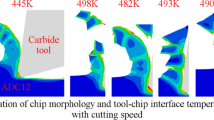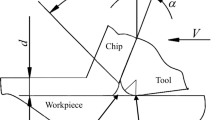Abstract
Chip formation, an important aspect of the high-speed cutting (HSC) mechanism, is generally accepted as the result of shear deformation in the shear zone and tool-chip friction. In order to accurately study chip formation process in HSC, a theoretical model for the high-speed orthogonal cutting of aluminum alloy 6061-T6 was built, which can be used to calculate the important parameters of chip formation, such as shear angle, friction angle, length of shear plane, tool-chip contact length, and width of the first shear zone. A series of orthogonal cutting experiments, with the YG6 carbide tool and on a wide range of cutting speed (100–1,900 m/min) and feed (0.06–0.15 mm/r), were performed in order to obtain the parameters required in the model, including the cutting forces, the chip thickness, and the shear slip distance. Seven kinds of chip formation parameters were obtained with different cutting parameters in the experiment, and the built theoretical model can well explain the formation process and the morphology characteristics of these chips, which proves that the combined method of theoretical model and orthogonal cutting experiment is an effective and easy approach to obtain the parameters of chip formation in HSC, avoiding the cutting speed limitation and the safety risk in quick-stop test. Within the range of parameters set in the experiments, the chip mainly appears to be continuous chip, curling chip, or discontinuous chip. And the chip thickness, friction angle, length of shear plane, and width of the first shear zone decrease with the increase of the cutting speed; meanwhile, the shear slide distance and shear angle increase.
Similar content being viewed by others
References
Schulz H (2001) Scientific fundamentals of HSC. Carl Hanser Verlag, Munich, pp 3–15
Ai X (2003) High speed cutting technology. National Defense Industry Press, Beijing, pp 4–10 (in Chinese)
Feng PF, Yu DW, Wu ZJ, Uhlmann E (2008) Jaw-chuck stiffness and its influence on dynamic clamping force during high-speed turning. Int J Mach Tools Manuf 48:1268–1275
Dolinsek S, Ekinovic S, Kopac J (2004) A contribution to the understanding of chip formation mechanism in high-speed cutting of hardened steel. J Mater Process Technol 157:485–490
Chandrasekaran H, M’Saoubi R, Chazal H (2005) Modelling of material flow stress in chip formation process from orthogonal milling and split Hopkinson bar tests. Mach Sci Technol 9:131–145
Simoneau A, Ng E, Elbestawi M (2006) Chip formation during micro-scale cutting of a medium carbon steel. Int J Mach Tools Manuf 46:467–481
Liu K, Li XP, Liang SY (2007) The mechanism of ductile chip formation in cutting of brittle materials. Int J Adv Manuf Technol 33:875–884
Pang JZ, Wang MJ, Qian M, Zhang J (2008) Chip morphology and cutting forces in high speed end milling of hardened P20 steel. China Mech Eng 19:170–174 (in Chinese)
Cotterell M, Byrne G (2008) Dynamics of chip formation during orthogonal cutting of titanium alloy Ti-6Al-4V. CIRP Ann Manuf Technol 57:93–96
Childs THC, Rahmad R (2009) The effect of a yield drop on chip formation of soft carbon steels. Mach Sci Technol 13:471–487
Khidhir BA, Mohamed B (2010) Study of cutting speed on surface roughness and chip formation when machining nickel-based alloy. J Mech Sci Technol 24:1053–1059
Yang Y, Li JF (2010) Study on mechanism of chip formation during high-speed milling of alloy cast iron. Int J Mach Tools Manuf 46:43–50
Sima M, Ozel T (2010) Modified material constitutive models for serrated chip formation simulations and experimental validation in machining of titanium alloy Ti-6Al-4V. Int J Mach Tools Manuf 50:943–960
Pawade RS, Joshi SS (2011) Mechanism of chip formation in high-speed turning of Inconel718. Mach Sci Technol 15:132–152
Calamaz M, Coupard D, Nouari M, Girot F (2011) Numerical analysis of chip formation and shear localisation processes in machining the Ti-6Al-4V titanium alloy. Int J Adv Manuf Technol 52:887–895
Su GS, Liu ZQ, Wan Y, Ai X (2012) The cutting speed influence mechanism on the mechanical properties and chip morphology of workpiece material in high-speed cutting. Sci China Technol Sci 42:1305–1317 (in Chinese)
Su GS, Liu ZQ (2013) Analytical and experimental study on formation of concentrated shear band of saw tooth chip in high-speed machining. Int J Adv Manuf Technol 65:1735–1740
Li AH, Zhao J, Zhou YH, Chen XX, Wang D (2012) Experimental investigation on chip morphologies in high-speed dry milling of titanium alloy Ti-6Al-4V. Int J Adv Manuf Technol 62:933–942
Cui XB, Zhao J, Tian XH (2013) Cutting forces, chip formation, and tool wear in high-speed face milling of AISI H13 steel with CBN tools. Int J Adv Manuf Technol 64:1737–1749
Cui XB, Zhao J, Jia C, Zhou YH (2012) Surface roughness and chip formation in high-speed face milling AISI H13 steel. Int J Adv Manuf Technol 61:1–13
Duan CZ, Zhang LC (2013) A reliable method for predicting serrated chip formation in high-speed cutting: analysis and experimental verification. Int J Adv Manuf Technol 64:1587–1597
Gu LY, Wang MJ (2013) Experimental and theoretical research on critical characteristics for adiabatic shear localization fracture in high-speed machining. Int J Adv Manuf Technol 68:1231–1240
Xu DC, Feng PF, Yu DW, Wu ZJ (2009) Research on warpage deformation of machining cantilever sheet part with combined saw milling tool. Key Eng Mater 407–408:528–532
Feng PF, Xu DCWZJ, Yu DW (2010) Comprehensive evaluation analysis and optimization methodology of tool geometric parameters for high speed cutting. Key Eng Mater 431–432:474–478
Xu DC, Feng PF, Yu DW, Wu ZJ (2010) Experimental study on chip shape and tool wear of high-speed and micro-feed cutting. Key Eng Mater 431–432:479–482
Lee WB, To S, Sze YK, Cheung CF (2003) Effect of material anisotropy on shear angle prediction in metal cutting-a mesoplasticity approach. Int J Mech Sci 45:1739–1749
Fu XL, Ai X, Liu ZQ, Wan Y (2007) Study on shear angle model of aluminum alloy 7050-T7451 in high speed machining. China Mech Eng 18:220–224 (in Chinese)
Wu CL, Wang KS, Tsai LC (2006) A new electromagnetic quick stop device for metal cutting studies. Int J Adv Manuf Technol 29:853–859
Zeb M, Veldhuis S, Irfan M (2009) Material response of remax-2 during high-speed machining using quick-stop device. Exp Tech 33:18–23
Chem GL (2007) Study on the influence of vibration cutting on chip formation using a modified quick-stop device. J Chin Soc Mech Eng 28:413–420
Merchant EM (1945) Mechanics of the metal cutting process II. Plasticity conditions in orthogonal cutting. J Appl Phys 16:318–324
Kovrizhnykh AM (2009) Determining the shear angle, forces and sizes of shearing elements during metal cutting. J Appl Mech Tech Phys 50:147–154
Toropov A, Ko SL (2006) Prediction of shear angle for continuous orthogonal cutting using thermo-mechanical constants of work material and cutting conditions. J Mater Process Technol 182:167–173
Shaw MC (2005) Metal cutting principles. Oxford University Press, Oxford, p 177
Xu DC (2010) Research on material constitutive equation, friction equation and process parameters optimization of high-speed cutting. Dissertation, Tsinghua University. (in Chinese)
Xu DC, Feng PF, Wu ZJ, Yu DW (2012) An improved method for acquisition of high-speed cutting zone temperature based on heat conduction reverse seeking. Adv Mater Res 426:197–200
Author information
Authors and Affiliations
Corresponding author
Rights and permissions
About this article
Cite this article
Xu, D., Feng, P., Li, W. et al. Research on chip formation parameters of aluminum alloy 6061-T6 based on high-speed orthogonal cutting model. Int J Adv Manuf Technol 72, 955–962 (2014). https://doi.org/10.1007/s00170-014-5700-3
Received:
Accepted:
Published:
Issue Date:
DOI: https://doi.org/10.1007/s00170-014-5700-3




